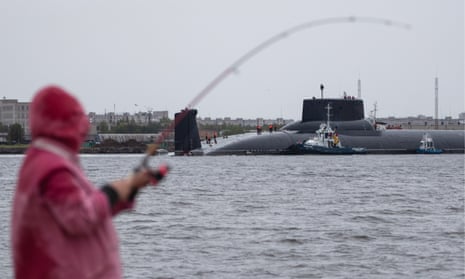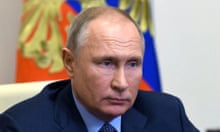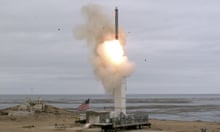Russia’s state meteorological service says it has identified four radioactive substances in samples taken from Severodvinsk, a city where radiation levels briefly spiked after a mysterious explosion at a site 18 miles (29km) away.
The explosion on 8 August killed at least five nuclear specialists from one of the premier research hubs run by the state nuclear energy corporation, Rosatom.
The substances were identified as “technogenic radionuclides” – strontium-91, barium-139, barium-140 and lanthanum-140. These are fast-decaying radioactive substances that would emit inert radioactive gases if exposed to the open air.
They were responsible for the “sharp, short-lived change in the radiation situation over Severodvinsk”, the meteorological service said. Roshydromet has been monitoring the situation but said no further radiation had been detected.
The findings appear to back up an official statement posted on the Severodvinsk city government website on 8 August. However, this disappeared after the Russian military denied there had been any emissions of radioactive material.
An earlier Roshydromet statement said radiation levels had jumped by between four to 16 times their usual level.
The Russian government and Rosatom have been vague about what happened. A Rosatom statement on 10 August after the blast said only that the device was an “isotopic power source in a liquid-fuel engine”, suggesting the incident was some kind of failed missile test.
A second Rosatom statement, issued by the head of the research institute where the five specialists worked, suggested the test involved either a small nuclear reactor or a radioisotope thermoelectric generator (RTG) – both of which have applications on spacecraft.
But the four radionuclides identified by Roshydromet on Monday are extremely unusual, according to Andrei Zolotkov, a chemist who spent 35 years working on Russia’s nuclear icebreaker fleet and knows the details of typical nuclear reactors.
The identified radionuclides are of a type that could be produced in a uranium-235 reaction commonly used in nuclear reactors. But even then, strontium-91 is exotic, he says. And other radionuclides, such as caesium-137, should have also been detected.
However, local media reports since 8 August have suggested doctors who treated victims of the explosion tested positive for caesium-137. Zolotkov believes there are two possible explanations: either the failed test involved a highly unusual reactor, or the latest findings are a diversion.
“These specified radionuclides rule out, to some extent, the possibility of an RTG,” Zolotkov said. “Usually, an RTG uses just one radionuclide, and during its decay, and it cannot produce these kinds of isotopes.”
This account would seem to fit with reports of two separate explosions on 8 August reported over the weekend by a Norwegian monitoring group.
Dr Edwin Lyman of the Union of Concerned Scientists said the detection of the fission products announced on Monday was indicative of a reactor release.
“However, I’m still puzzled why there was no detection of iodine isotopes, some of which would be released in greater quantities,” he said.
“As to what kind of reactor was being tested, there are two main possibilities: it was either a nuclear ramjet engine, which would be air-cooled, or a more conventional reactor using a coolant like hydrogen. Again, I’m puzzled why, if it were a ramjet engine in a rocket, it would have been started on the ground, since those reactors require air to flow through them at a high speed to operate.”
Asked if there had been a reactor blast, Rosatom referred back to its statement on 10 August.








